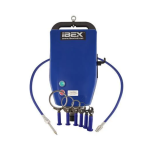
Asthma, a chronic respiratory condition affecting millions worldwide, demands comprehensive management strategies to ensure patients lead a quality life. Among the various treatment modalities, the blue asthma inhaler, often referred to as a rescue inhaler, plays a pivotal role.
Understanding Asthma and Its Impact
Asthma is characterized by inflammation and narrowing of the airways, leading to symptoms such as shortness of breath, wheezing, chest tightness, and coughing. These symptoms can vary in severity and frequency, often triggered by factors like allergens, exercise, cold air, and stress. The unpredictable nature of asthma necessitates having an effective and immediate treatment option on hand, which is where the blue asthma inhaler comes into play.
What is the Blue Asthma Inhaler?
The blue asthma inhaler is a short-acting beta-agonist (SABA) used primarily for quick relief from asthma symptoms. It contains medication such as salbutamol (albuterol in the US), which works by relaxing the muscles around the airways, thereby opening them up and making it easier to breathe. This rapid action makes the blue inhaler an essential tool for managing acute asthma attacks and preventing exercise-induced bronchoconstriction.
Mechanism of Action
Upon inhalation, the medication in the blue asthma inhaler targets the beta-2 receptors in the smooth muscles of the airways. This interaction leads to muscle relaxation and dilation of the bronchial passages, which helps to alleviate symptoms almost immediately. The effects of a single dose can last for several hours, providing temporary relief and allowing patients to resume their normal activities.
Proper Usage and Techniques
To maximize the effectiveness of the blue asthma inhaler, proper usage is crucial. Here are the key steps:
- Shake the inhaler well before use to ensure the medication is adequately mixed.
- Exhale completely to empty the lungs.
- Place the mouthpiece in the mouth, creating a tight seal with the lips.
- Inhale deeply and slowly while pressing down on the inhaler to release the medication.
- Hold the breath for about 10 seconds to allow the medication to settle in the airways.
- Exhale slowly and repeat if a second dose is required, as prescribed by a healthcare provider.
Using a spacer device can enhance the delivery of medication to the lungs, especially in children and older adults who may struggle with the coordination required for proper inhaler use.
Benefits of the Blue Asthma Inhaler
Immediate Relief
The most significant benefit of the asthma inhaler is its ability to provide rapid relief from acute asthma symptoms. This immediacy can be life-saving during severe asthma attacks, preventing further complications and the need for emergency medical intervention.
Convenience and Portability
The compact design of the blue asthma inhaler allows patients to carry it conveniently, ensuring they have access to medication whenever and wherever needed. This portability is particularly beneficial for those with unpredictable asthma triggers.
Preventive Use
In addition to managing acute symptoms, the blue inhaler can be used prophylactically before engaging in activities known to trigger asthma symptoms, such as exercise. This preventive use helps maintain an active lifestyle without fear of exacerbating asthma.
Considerations and Precautions
Frequency of Use
While the blue asthma inhaler is essential for immediate relief, it is important not to overuse it. Overreliance on the inhaler can indicate poorly controlled asthma, necessitating a review and adjustment of long-term management strategies. Patients should adhere to the prescribed dosage and consult their healthcare provider if they find themselves needing the inhaler more frequently than recommended.
Side Effects
Common side effects of short-acting beta-agonists include tremors, nervousness, headache, and an increased heart rate. These side effects are generally mild and transient. However, if they persist or become severe, medical advice should be sought.
Asthma Action Plan
Every asthma patient should have a personalized asthma action plan developed in collaboration with their healthcare provider. This plan outlines how to manage daily asthma symptoms when to use the blue inhaler, and steps to take during an asthma attack. Regular reviews of this plan help ensure it remains effective and up-to-date with the patient’s current condition.
Integrating the Blue Asthma Inhaler into Comprehensive Asthma Management
Effective asthma management is a multifaceted approach that includes the use of the blue asthma inhaler for acute relief, along with long-term control medications and lifestyle modifications. Here’s how to integrate the blue inhaler into a comprehensive asthma management plan:
Long-Term Control Medications
Long-term control medications, such as inhaled corticosteroids, leukotriene modifiers, and long-acting beta-agonists, are prescribed to manage chronic inflammation and prevent asthma symptoms. These medications are taken daily and work by reducing airway inflammation and sensitivity, thereby minimizing the frequency and severity of asthma attacks.
Environmental Control
Identifying and avoiding asthma triggers is a key component of effective asthma management. Common triggers include allergens, irritants, respiratory infections, and physical exertion. Patients should work to minimize exposure to these triggers through measures such as:
- Using air purifiers and maintaining clean indoor environments
- Avoiding smoking and secondhand smoke
- Wearing masks during high-pollen seasons
- Practicing good hygiene to prevent respiratory infections
Regular Monitoring and Medical Reviews
Regular monitoring of asthma symptoms and lung function helps assess the effectiveness of the treatment plan. Tools such as peak flow meters can provide valuable insights into lung function, allowing for timely adjustments to medications. Routine check-ups with healthcare providers ensure that the asthma action plan is optimized for the patient’s needs.
Patient Education and Self-Management
Educating patients about asthma, its triggers, and the proper use of medications empowers them to take an active role in managing their condition. Self-management techniques, including recognizing early signs of an asthma attack and knowing when to seek medical help, are crucial for maintaining control over asthma.
Visit More Information: Genericvilla
Conclusion
The blue asthma inhaler is an indispensable tool in the arsenal of asthma management, providing immediate relief from acute symptoms and enabling patients to lead active, fulfilling lives. When used correctly and as part of a comprehensive asthma management plan, it significantly enhances the quality of life for asthma patients. By understanding its role and integrating it with long-term control strategies, patients can achieve effective and sustained asthma control.

